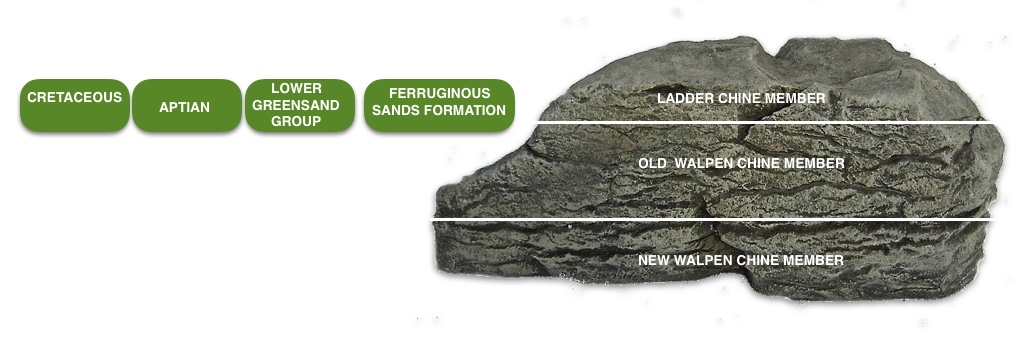Shanklin is a very good location on the Isle of Wight for Lower Greensand fossils, in particular, dinosaur remains and molluscs. When the Lower Greensand is exposed to air and left to dry, it becomes extremely hard. However, when fresh and, especially when exposed on the foreshore, it is like clay.
DIRECTIONS
♦ From Shanklin, head to the seafront and continue towards Hope Beach, which is clearly signposted.
♦ At Hope Beach, you will find a large car park (“Little Steps Point Car Park”) with a complex of shops and services . Once on the beach, walk south. You will have to pay to use the car park.
♦ Warning, the beach can be very sticky and dangerous. Take extreme care.
♦ Toilets, a cafe and local shops can be found at the large car park.
♦ Ref: SZ 58870 82414
PROFILE INFO
FIND FREQUENCY: ♦♦♦ – Fossils are mostly found along the foreshore, washed out from the soft greensand cliffs, especially south of Shanklin and heading towards Luccombe. Dinosaur bones and molluscs are the most likely fossils to be found.
CHILDREN: ♦♦♦ – Older children can visit this location as long as they keep away from the base of the cliff, and if the foreshore starts to become too sticky, we recommend turning back. Depending on conditions, often the beach is worst the further South you go.
ACCESS: ♦♦♦♦ – The walk from the car park is short and the location is easy to find. I would have given this site a five-star rating, but the soft clay on the foreshore can often make the location dangerous.
TYPE: – Fossils are found washed out of the cliffs along the foreshore. You can easily pick them up just by walking along the beach.
FOSSIL HUNTING
There are many fossil locations on the Isle of Wight to visit and Shanklin/Sandown is one of the lesser known locations for dinosaur remains. To the south of Shanklin, there are excellent exposures of Lower Greensand. This can become very hard when it is exposed to dry air and collecting fossils from this hardened rock requires heavy hammers and sharp chisels. Blocks, boulders and pebbles of this hardened rock can be found all over the beach.
However, when fresh and unexposed to air, the greensand is soft and much easier to collect from. During scouring conditions, this softer type enables you to extract fossils simply using a knife or trowel, and any fossils you do find will be in excellent condition. Providing you clean them as soon as possible, they will self-harden with minimal work involved in preparing.
Fossils are more commonly found along the foreshore, either loose or in the rocks. Dinosaur bones washed from the greensand beds can often be found by simply walking along the foreshore, without the need of any tools. Molluscs can also be found in the greensand, but are more likely to be found in the greensand slips near the cliffs.
Older children can visit this location, as long as they keep away from the base of the cliff. Depending on conditions, the state of the beach often becomes worse the further south you walk. If the foreshore is too sticky, it is best to turn back.

GEOLOGY
The rock mass of the cliffs is composed entirely of Ferruginous Sands of the Lower Greensand (Cretaceous) Series overlain by weathered sands and superficial deposits. The formation comprises a number of heavily bioturbated coarsening-upward units each comprising dark grey sandy muds or muddy sands passing up into fine- to medium-grained grey to green glauconitic sands.
The Ferruginous Sands are quite varied in their degree of cementation but are predominantly friable, weakly cemented fine to medium sands. However, within the sequence there are bands of more Ferruginous material which could be described as Sandstone, where the degree of
cementation is higher and the resistance to failure and erosion is greater so they often stand proud of the cliff face.
The Ferruginoius Sands cliffs at Shanklin contain three formations;
- the New Walpen Chine Member (of which the bulk of the cliffs are made up,
- the Old Walpen Chine Member, the lowest beds exposed on the foreshore consist of.
- the Ladder Chine Member, exposed at Little Stairs Point, where a fault known as the ‘Little Stairs Fault Complex’ appears, with the north side exposing the Ladder chine Member and the Old Walpen Chine Member, with the south side exposing the Old Walpen Chine Member and New Walpen Chine Member.


SAFETY
This can be a dangerous location. As well as tall cliffs, which are dangerous because they are constantly crumbling, the sea often reaches their base. In addition, there are large boulders lying around, so you also have a soft and dangerous foreshore to contend with, in which you can easily become stuck. Therefore, extreme care should always be taken.
EQUIPMENT
Wellington Boots are essential here; a heavy hammer needed for the hard Greensand Blocks and a trowel for the soft material. Bags are also recommended to put any finds into. A chisel may also be needed if working with the large blocks.
ACCESS RIGHTS
There are no restrictions at this location, but please follow the our UK Fossils Code of Conduct.
It is important to follow our ‘Code of Conduct’ when collecting fossils or visiting any site. Please also read our ‘Terms and Conditions‘
LINKS
♦ Buy Fossils, Crystals, Tools
♦ Location Discussions
♦ Deposits Magazine
♦ Join Fossil Hunts
♦ UK Fossils Network














